HUMBOLDT, KS:
A CIVIL WAR SURVIVOR
Swipe right to learn more at each stop.
Confederates raided and burned the town of Humboldt, Kansas, in September and October 1861, handing the town a blow from which many communities would not have recovered.
This tour is dedicated to those who founded this community and suffered with it during difficult and trying times, and to those who have kept its spirit strong.
This tour is dedicated to those who founded this community and suffered with it during difficult and trying times, and to those who have kept its spirit strong.
This tour includes 12 stops. Download a copy of the tour using the button below.
Scroll down to begin the tour.
MAPScroll down to begin the tour.
Background
The German settlement of Humboldt, Kansas, was founding 1857 on the bluffs of the Neosho River. Log houses and stores were soon erected in the woods and prairie adjacent to the river.
The first pro-slavery legislature of the Kansas Territory in 1855 designated Cofachique, a pro-slavery town, as the county seat. Humboldt was founded by Free Sate advocates, and in 1858 the county seat was relocated to Humboldt.
The first pro-slavery legislature of the Kansas Territory in 1855 designated Cofachique, a pro-slavery town, as the county seat. Humboldt was founded by Free Sate advocates, and in 1858 the county seat was relocated to Humboldt.
With the passage of the Kansas-Nebraska Act in 1854, guerrilla warfare broke out between the slave state of Missouri and the mostly anti-slavery settlers in Territorial Kansas. Controversy revolved around whether Kansas would enter the Union as a slave state or a free state. Because of its isolated location, Humboldt escaped active involvement with the Border Wars; however, it was near Osage Indian land and was vulnerable to attack from guerrillas and hostile Indians who favored the Confederacy.
On January 29, 1861, Kansas was admitted into the Union as a free state. Fighting continued between Kansas and Missouri over the issue of slavery, and in April, the Civil War officially began. That summer an infantry company was organized at Humboldt and ordered to duty in Missouri leaving the women, children, and older men in the town vulnerable to attack.
With the men away, a band of Cherokee and Osage Indians and guerrillas seeking runaway slaves attacked Humboldt on September 8, 1861, under the command of Captains Mathews and Livingston. Mathews, a trader among the Osage, was married to an Osage woman and had recruited many of the Osage tribe for the Confederacy.
With the men away, a band of Cherokee and Osage Indians and guerrillas seeking runaway slaves attacked Humboldt on September 8, 1861, under the command of Captains Mathews and Livingston. Mathews, a trader among the Osage, was married to an Osage woman and had recruited many of the Osage tribe for the Confederacy.
Humboldt, with a population of 100 families, was raided, with stores and homes robbed of any money and valuables the raiders could find. With the men absent, there was little resistance.
Hearing of the raid, General Jim Lane sent a column of cavalry under Col. Blunt to chastise the raiders. Mathews was hunted down near Chetopa and shot as he ran for his horse.
Hearing of the raid, General Jim Lane sent a column of cavalry under Col. Blunt to chastise the raiders. Mathews was hunted down near Chetopa and shot as he ran for his horse.
Soon afterward, the Home Guard was formed of old men, boys, and a few of the militia who returned after learning of the raid.
At about 4 pm on October 14, 1861, a Confederate cavalry suddenly invaded Humboldt. The Home Guard were caught by surprise at O'Brien's Mill where they were quartered.
Most of the buildings were set afire after the women and children were allowed to remove valuable possessions and household goods. Rebels moved through the town, setting torches to homes and businesses.
At about 4 pm on October 14, 1861, a Confederate cavalry suddenly invaded Humboldt. The Home Guard were caught by surprise at O'Brien's Mill where they were quartered.
Most of the buildings were set afire after the women and children were allowed to remove valuable possessions and household goods. Rebels moved through the town, setting torches to homes and businesses.
The night was illuminated by the flames of the burning town. The roaring of the fire and the crashing of the buildings could be heard for miles around. Nearly the whole town lay in ashes and ruin.
The invading troops were made to think that a defending force was on its way, so they did not remain. The captives, who had been taken a short distance from town, were released.
As a result of the raid and the burning of the town, a Union battalion was stationed at Camp Hunter, Humboldt. The troops were housed in Log Town, about 12 to 15 houses built by soldiers in the scrub oaks along the Neosho River.
The invading troops were made to think that a defending force was on its way, so they did not remain. The captives, who had been taken a short distance from town, were released.
As a result of the raid and the burning of the town, a Union battalion was stationed at Camp Hunter, Humboldt. The troops were housed in Log Town, about 12 to 15 houses built by soldiers in the scrub oaks along the Neosho River.
An active garrison was stationed at Camp Hunter for the duration of the war.
After the Civil War was over, Humboldt prospered.
After the Civil War was over, Humboldt prospered.
Stop 1
DIRECTIONS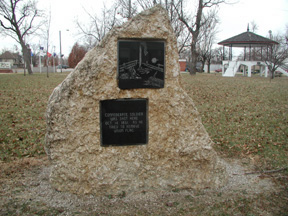
The only Confederate killed during the burning of Humboldt was shot here as he attempted to removed the Union flag from a flagpole. For over 150 years, the answer to who shot the Confederate has remained a mystery. Unexpectedly, in late summer 2013, the mystery was solved! Research by Wisconsin genealogist, Carolyn Kuczmarski, disclosed that it was her ancestor, John Bradford Tibbetts, KS 9th, Co G, "a hot-headed Union man with a long-barreled rifle" who brought down the Confederate. Using the City of Humboldt's Online Mount Hope Cemetery list, Carolyn and her grandson Aaron found John Tibbetts, his wife Amy, and their offspring buried at Mt. Hope north of Humboldt on Hawaii Road west of Hwy 169.
Stop 2
DIRECTIONSAnyone who bought land in this part of the state from 1861 to 1871 had to come to Humboldt's Land Office to transact business. At first, the Land Office was a small red frame building on Bridge Street. After the burning, it occupied several different buildings, including the 1866 two-story brick structure at 8th and New York restored by the Humboldt Historic Preservation Alliance, Inc.
Stop 3
DIRECTIONSIn March of 1857, J.A. Coffey paid $20 for Humboldt's town site. Early dwellings were log cabins near the river, but the first frame building, erected at the corner of 8th and Bridge Streets, was the residence and store of the Coffeys. Set on fire during the burning, the building was saved by Mrs. Louisa Coffey's quick thinking and wet laundry.
Stop 4
DIRECTIONSDuring the burning, the women of Humboldt behaved nobly. They succeeded in making the invaders believe an armed force was on its way from Iola. When Rebel soldiers were ordered to remove items from homes before burning them, Sophia Fussman bravely hid account books and other valuables on a feather bed which she threw down the well then hid herself and her children in the tall prairie grass and timber behind her house.
Stop 5
DIRECTIONS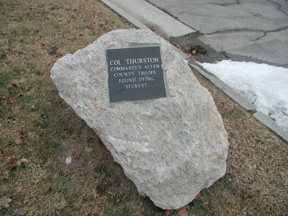
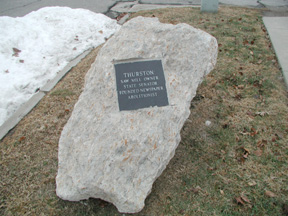
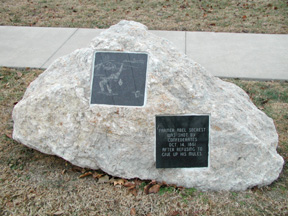
Driving his mules east from the river toward his home north of Bridge Street, Abel Secrest was shot in the shoulder for refusing to halt. Three days later he was found by Col. Thurston in the timber north of his place. It was doubtful that Abel saved his mules; he died from the gunshot wound, the only resident of the town to die as a result of Confederate attack during the October 14 burning.
Stop 6
DIRECTIONSIn the spring of 1858, W.C. O'Brien opened the first grist mill in the county. After the September raid, Captain Miller (first doctor to come to Humboldt) used the mill to quarter the Home Guard of about 100 men, many of whom were captured Oct. 14, prior to the burning, then later released.
Stop 7
DIRECTIONS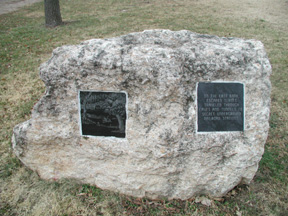
Severe drought in 1859 and 1860 caused the Neosho River to stop flowing. This fact supports the theory that escaped slaves from Missouri headed north could have walked the river at night and slept in numerous east bank caves, still in existence, by day. Linked to the caves were hand-dug tunnels, south of the present river bridge, that led to several hiding places: a shack with a trap door located on this property, and Aunt Polly's cabin near Sycamore. Thurston's Ford, north of the present river bridge, led to Thurston's property. Other opportunities for slaves to escape into Kansas were sometimes provided by Jayhawkers during their raids on Missouri towns before and during the Civil War.
Stop 8
DIRECTIONS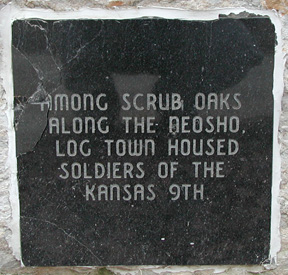
After the burning in October of 1861, Camp Hunter was established, and at various times troops from the 9th, 11th, and 7th (Jayhawkers) Kansas Cavalry Regiments were garrisoned here. The men were billeted in Log Town. It is here that Pvt. Alexander Driscoll was executed for desertion by firing squad March 8, 1862.
Stop 9
DIRECTIONSAunt Polly Crosby, a daughter of slaves, lived in a cabin on Sycamore Street between 1st and 2nd. She was famous for her fried pies and generous spirit. The Cabin was probably part of the Underground Railroad, although Aunt Polly did not arrive in Humboldt until later. The Poplar Grove Baptist Church first held services at Polly's Cabin in 1879.
Stop 10
DIRECTIONSA block house was started here as part of Log Town and Camp Hunter. A small force of the 11th Kansas were stationed here under the command of Major Haas. A cannon stood on the grounds. It was a recruitment station.
Stop 11
DIRECTIONSOn October 14, after Dr. Wm. Wakefield's instruments were stolen and his horse taken by rebels, he invited Confederate officers home to supper, which he knew would be ready by 6 pm. The stable had been burned and soldiers were carrying out furniture when they arrived. He persuaded his wife, Emmarilla, to serve supper to save the house, but she was aghast to see Capt. Livingston, one of the Sept. Missouri Guerrilla raiders, at her table.
Stop 12
DIRECTIONS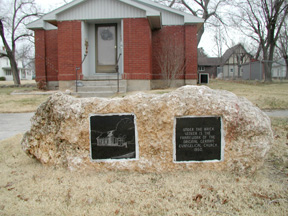
After the Confederate raid, Union Capt. George Miller hid the Home Guard's ammunition supply here in the German Evangelical Church. In October, when 331 Confederate troops came to burn Humboldt, Col. Talbot spared the churches, thereby unknowingly saving the ammunition. Later government rations for Log Town and Camp Hunter were kept at the church.
Epilogue
Recent Findings about Humboldt and Possible Underground Railroad Activity
Research has uncovered three 1861 newspaper accounts from Fort Scott, Lawrence and Emporia reporting that, during the September 1861 Confederate raid on Humboldt, 8 to 12 fugitive slaves hiding in Humboldt were kidnapped by the raiders and returned to Missouri.
On the east bank of the Neosho River, north of the present river bridge, a sandstone building still stands on the Colenel Orlin Thurston property. It may have sheltered escaping slaves who came from Missouri. A tunnel once led from the building to the river bluff where a small cave entrance provided access. Thurston and his friend, Captain George Miller, a doctor, were said to have given food and aid to fugitive slaves who stopped at the Thurston place.
On the east bank of the Neosho River, north of the present river bridge, a sandstone building still stands on the Colenel Orlin Thurston property. It may have sheltered escaping slaves who came from Missouri. A tunnel once led from the building to the river bluff where a small cave entrance provided access. Thurston and his friend, Captain George Miller, a doctor, were said to have given food and aid to fugitive slaves who stopped at the Thurston place.
More about Camp Hunter
Camp Hunter/Log Town is now Camp Hunter Park at the west end of Pine Street. In the spring of 1862, the Kansas 7th Union Cavalry were briefly stationed there. The notorious Kansas 7th, also known as Jayhawkers or Red Legs, murdered, pillaged, and burned Missouri's Confederate settlements. Under the leadership of the equally infamous Colonel Jennison, Jayhawkers were encouraged to rebel against most commonly respected army regulations.
In March of 1862, Private Driscoll took Jennison at his word when he broke out of the Camp Hunter jail where he was being held for desertion and stole Colonel Dan Anthony's horse. Col. Anthony was Commander of the Jayhawks at Camp Hunter. After a brief court-martial, Driscoll was shot by firing squad on March 8, 1862, under the very elms of our Camp Hunter Park.
Also in 1862, 1,000 Indians and Blacks marched four abreast from LeRoy, Kansas to Camp Hunter, forming the First Indian Home Guard regiment. These Troops were among the refugees who fled with Opothleyahola, Creek leader, from Indian Territory into free-state Kansas.
Also in 1862, 1,000 Indians and Blacks marched four abreast from LeRoy, Kansas to Camp Hunter, forming the First Indian Home Guard regiment. These Troops were among the refugees who fled with Opothleyahola, Creek leader, from Indian Territory into free-state Kansas.
FREEDOM'S FRONTIER NATIONAL HERITAGE AREA
1047 MASSACHUSETTS ST
LAWRENCE, KS 66044
785.856.5300
SIGN UP FOR THE MONDAY MINUTE
Read the latest news about Freedom's Frontier and its partners every week.
SIGN UP FOR HISTORY HAPPENS
Stay up to date on events in the heritage area with this biweekly newsletter.